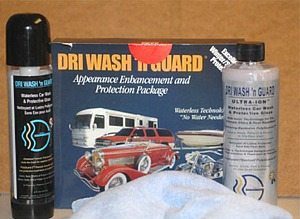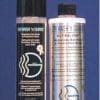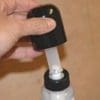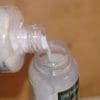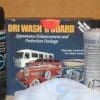Editor’s Note: We were originally pleased but not overwhelmed with the Dri Wash ‘n Guard product when we first tried it.
Since this article was originally posted, DWG International sent us the correct, retail sized container and the special aerosol pump spray container used to apply the product, rather than the very small sample sprayer that was used in the first trial.
The pump makes a big difference in the performance of the product, and we’ve since become fans of Dri Wash ‘n Guard.
Keeping a motorcycle clean isn’t always as easy as it seems — or as easy as it should be. Especially if you’re a neat freak like me. Something about hosing down a motorcycle and slobbering car wash all over the exposed parts and wires just doesn’t seem right.
But motorcycles seem to attract more grit, grime and bugs than anything else on the road. That means that if a motorcycle isn’t cleaned on a regular schedule, it can quickly develop a real bad case of the uglies.
And squashed bug bodies need to be rinsed off pronto, or the paint can be permanently damaged. If you’ve ever been hit by a “love bug” in Florida, you know what I mean. Those babies must have blood with an acid content worse than the creature in the movie “Alien”!
After rinsing off the suds, I feel guilty unless I run at least a quick coat of polish over the paint. Then there’s the chrome, so that gets a treatment.
And don’t forget about the wheels, the windscreen, the black plastic parts that need Armor All and just like that, 3 hours of good riding time are lost to an obsessive compulsive cleaning disorder. Sure, the bike looks good for the next ride or two, but in no time at all, the grime is back.
So when we received a sample of DWG Dri Wash ‘n Guard, I was intrigued. What a concept: a product that can keep a motorcycle clean without having to drag out the hose and bucket every weekend! Dri Wash ‘n Guard claims to be a combination “car wash, polish and protective glaze which is applied directly to a dirty surface without the use of water”.
DWG International, the manufacturer of the product, says that the Dri Wash ‘n Guard recipe has “47 different ingredients” that have never been used in the car care industry. Some of these ingredients are special detergents and wetting agents that are supposed to help loosen the dirt on a painted finish or any non–porous surface, including glass and chrome.
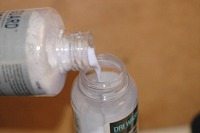
The product comes in a separate 16 oz. container, which must be shaken prior to use. It definitely does not look like any other type of car wash, polish or wax that we’ve ever seen. A milky substance that settles on the bottom during shipping quickly incorporates into the purplish liquid as the contents are mixed.
The liquid is then poured in to a special “AIRosol” spray container that’s designed to lay a fine mist over the surface to be treated.
The AIRosol container is pressurized by using a special pumper top and about 5-10 strokes. We had originally used a pre-mixed sample of the product that came in a tiny 1/2 oz. or so spray bottle, which made it difficult to use.
But the AIRosol spray bottle that comes with the Dri Wash ‘n Guard package does a much better job and spreads a nice, thin but hefty pattern on the painted surface. A little bit of the sprayed liquid goes a very long way; it doesn’t take much at all to do the job, so a 16 oz. bottle should last for many applications.
DWG International recommends spraying on a light coat with a sweeping motion, and then immediately wiping it off and buffing the finish with a clean terry cloth towel.
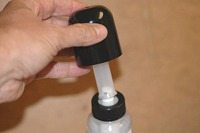
Some of the Dri Wash ‘n Guard kits are supplied with an ultra-soft terry cloth towel that’s perfect for this use. The result is a finish that DWG International says is “cleaned, polished, sealed and UV protected”.
It sure looks that way to us — it takes no time at all to buff out the liquid and like magic a nice, clean, shiny surface appears. When we tried the product again using the normal size bottle and applicator, we were much more impressed with its ability to quickly clean the painted surfaces on motorcycles and with the quick and lustrous shine that it produced.
It must have been a matter of getting the correct amount on the painted surface — the very small sample bottle we first tried did not allow the correct amount of liquid to be sprayed on the test motorcycles.
Note that the Dri Wash ‘n Guard Waterless Car Wash won’t remove tiny “spider web” scratches in the motorcycle’s paint; for that you’ll need some elbow grease and your favorite polish. But it cleans and shines in one easy step, and that’s important.
Small bottle or no, it still takes a while to get used to cleaning and polishing a motorcycle’s painted surfaces without a hose and a bucket o’ suds. It may not seem right to drown a motorcycle with a garden hose, but it also goes against conventional (read: old-fashioned) wisdom to spray and wipe anything other than soapy water on a dirty surface.
Decades of habit and urban myth have told us that lots of soapy water is best for removing any surface dust and dirt and also for loosening up the tougher stuff like bug residue and tar, but now that we’re in the 21st Century, I guess that’s old-style thinking.
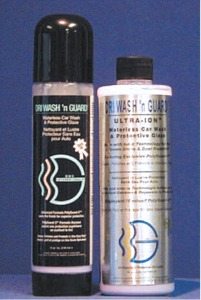
A clean sheepskin wash mitt is supposed to be the way to go when washing a painted surface with soap and water. A clean terry cloth towel will also work, but a sponge is a no-no — supposedly, it can collect bits of dirt and sand and grind them into the paint, causing scratches.
The soap is supposed to help float away the dirt and also acts as a lubricant to theoretically carry away the particles without scratching. Warm soapy water can be used to soak bug residue and tar, which then should be fairly easy to remove with a light rub from a sheepskin or terry wash rag.
But DWG International claims that their product can be used to spray and wipe, because the “detergents and wetting agents in Dri Wash ‘n Guard combine to soften and emulsify surface grime”, so I’ll take their word for it.
DWG International recommends that Dri Wash ‘n Guard is used only on surfaces with light dust or dirt. DWG International’s website FAQ page states that “Mud, clay, granules, heavy salt spray, bugs, heavy tar and tree sap are examples of things that cannot and should not be polished with DRI WASH ‘n GUARD”.
The FAQ goes on to state “Let common sense be your guide-if in doubt, rinse off the vehicle before applying DRI WASH ‘n GUARD.”
It’s interesting to note that DWG International calls the product a “polish” in this case. Unfortunately, mud, clay, bugs and tar are some of the most common substances that seem to be attracted to motorcycle finishes, so this caveat is something to consider, but for average dust and road grime, it seems to work very nicely.
The product sprays on easily in a very fine mist, and it clings to the painted surface differently than the other products, so there must be something different about it. Maybe it’s the “ionic technology”?
It seemed to remove light surface dust and dirt more efficiently than the other products that we tried, and it doesn’t take much effort to wipe it off and buff the surface. The Dri Wash ‘n Guard left a nice shine and it also left a “slippery silky” feeling on the finish, similar to what would be expected after using an automotive polish.
For comparison, we also tried Meguiar’s “Quick Detailer Mist & Wipe”, which can also be used as a waterless cleaner, according to the manufacturer. Meguiar’s claims that Quick Detailer Mist & Wipe can be used “right after a rainstorm, dust storm (!) or any other condition that ruins your ‘just waxed’ appearance”.
The wording on the container also states that the product has a “safe, high lubricity formula (that) lifts off dirt and grime without scratching”.
The Meguiar’s product beaded up and didn’t cling to the surface as well as the Dri Wash ‘n Guard, so it might not be as efficient in lubricating all the surface dust. It didn’t feel like it removed the dirt as well as the Dri Wash ‘n Guard; it felt more like the dirt was being pushed around rather than lifted off.
The Quick Detailer left a shine on the painted surfaces, but it didn’t have the same silky feeling as the Dri Wash ‘n Guard. Our impression was that this product works as a quick polish, but isn’t as effective as the Dri Wash ‘n Guard when used as a waterless cleaner.
Just for kicks, we also tried Plexus “Plastic Cleaner Protectant & Polish” in a spray aerosol can, although the manufacturer makes no claims regarding its ability to clean dirty surfaces on anything other than plastics. This product was slightly more effective at removing some of the tougher spots of bug residue and tar. But it’s not really designed to be used as a replacement for regular car wash. It leaves a “slippery” feel to the surface also.
We then tried Sprayway Glass Cleaner (see the wBW review), which we’ve found to be a versatile cleaner for use on motorcycle helmets, visors and windscreens. This product is also effective at removing bugs and tar, but it does not leave that “just waxed” feel, so we’d have to guess that it does not provide any surface treatment, which is to be expected. We don’t suggest that this product should be used as a substitute for car wash either.
We’ve also discovered that Stoner’s Tarminator “Tar, Grease & Sap Remover” is a good product to have around the garage, and it works great for cleaning tar spots and grease or oil, especially from engine casings. It’s not very effective at removing the bug residue on our sample bikes.
Because this product is designed to remove grease, it also removes any traces of polish or wax from painted surfaces, and it gives the surface a “squeaky clean” feeling that usually means that any protective wax coating has been stripped off the paint. We suggest using this only on engine casings but not on painted finishes.
Finally, we have Glass Plus, the old standby. I go through gallons of Glass Plus and we always keep a few bottles handy in the garage. I’ve been using this product as a “waterless” cleaner for many years. When I’m in a rush and don’t want to break out the garden hose, I’ve found that a good soaking with Glass Plus and a clean terry cloth towel seems to do a pretty good job of removing dirt and grime from a motorcycle’s painted surfaces or engine parts.
Spraying some Glass Plus on the bug residue and letting it soak for a while seems to help make it easier to clean. I still feel guilty about doing this, but my guilt is somewhat assuaged by telling myself that the volume of liquid in the Glass Plus spray helps to slide the cleaning towel over the surface and won’t cause any scratching.
However, the product is not designed to leave any protective agents on the paint, so it’s usually necessary to treat the surface with a coat of auto polish; something like the Meguiar’s Quick Detailer works well in this application
Conclusion
We’ve changed our mind about Dri-Wash ‘n Guard when it’s used as directed and it’s applied with the special pump sprayer. It is effective at removing dust and dirt, and it definitely seems to work differently than any other products that might be used to clean a motorcycle. It left a nice finish that feels similar to a just-waxed surface.
Soap and water may still be called for when the grime or mud is extreme, but Dri Wash ‘n Guard will save a lot of time keeping your bike looking great with a minimum of fuss.
Our experience shows that the 16 oz. bottle lasts a long time because a small amount of the product goes a long way, so the price may be worth the savings in time and effort. I absolutely hate dragging out the hose and bucket, so I think the cost is definitely worth the reduction in aggravation.
More information also at Waterless Car Wash Products
| Product Review: Dri Wash ‘n Guard Waterless Car Wash | |
| Available From: No Water Required;(Manufactured by DWG International) | Suggested Retail Price: $29.95 for 16 oz. bottle |
| Product Comments: Waterless car wash, claimed to leave a protective finish. Small amount seems to go a long way; cleans painted surfaces and leaves a nice shine all in one step. | Made in: U.S.A. |
| UPDATE – REVISED: We took a second look at the Dri Wash ‘n Guard Waterless Car Wash; see text | |
| More: Motorcycle Accessories Page | Motorcycle Repair and Maintenance Page | Motorcycle Wash, Cleaners & Polish Reviews | |
Note: For informational use only. All material and photographs are Copyright © webWorld International, LLC – 2000-2011. All rights reserved. See the webBikeWorld® Site Info page. NOTE: Product specifications, features and details may change or differ from our descriptions. Always check before purchasing. Read the Terms and Conditions!
Owner Comments and Feedback
Not all comments will be published (details). Comments may be edited for clarity prior to publication.
From “G.B.” (4/09): “I just thought I would mention that the best thing about waterless cleaners is you can wash your bike during the winter. I ride to and from work year round as well as riding missions with the Patriot Guard and the American Legion Riders. Nothing like flying down a 4 lane at seventy when it was 5 degrees.
During the last half of December, all of January and February my garden hose is winterized (coiled, un-hooked from the faucet and drained) hanging on the side of the house. Usually it is froze in that coiled shape and is basically not usable, not that I would want my hands in cold water outside in the Kansas winter. This is really when a waterless cleaner is nice.”


